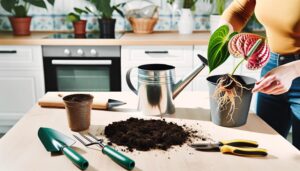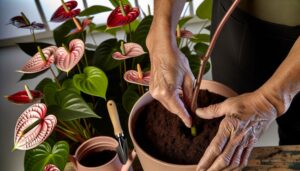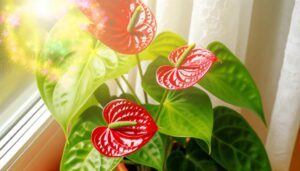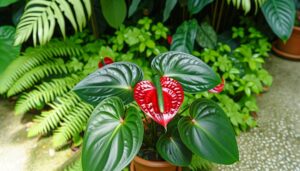Reviving Anthurium Leaves and Flowers That Turn Brown
To revive Anthurium leaves and flowers turning brown, start by adjusting light exposure—ensure they're in bright, indirect sunlight. Avoid direct sunlight which burns leaves.
Water when the top inch of soil is dry, using well-draining soil, and never let roots sit in standing water. Humidity is vital; mist leaves or use a humidifier.
Check for pests like aphids or spider mites and treat with neem oil if found. Finally, use a balanced, water-soluble fertilizer to keep your plant healthy.
For more precise upkeep strategies and troubleshooting steps, continue on.
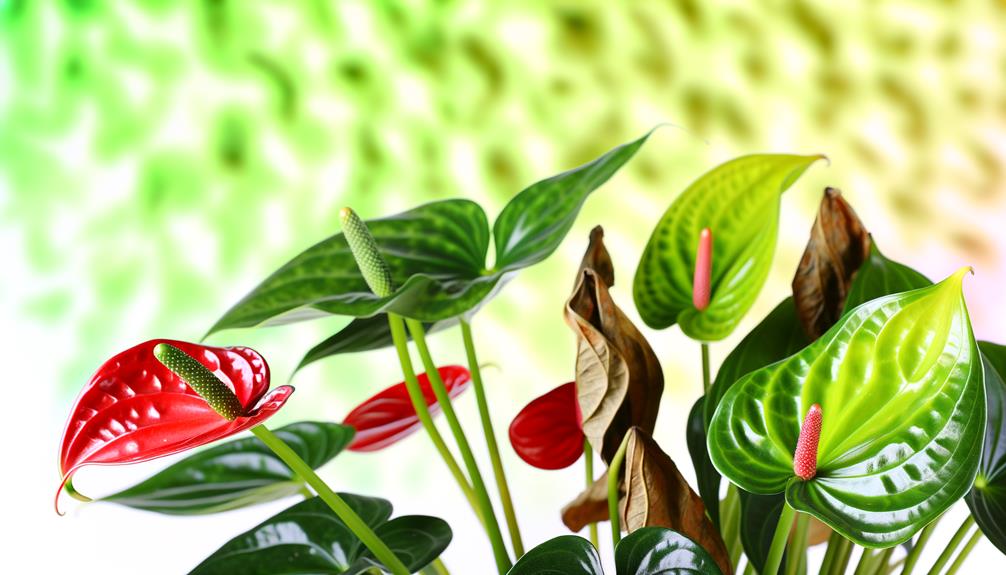
Key Takeaways
- Ensure Anthurium receives bright, indirect sunlight to avoid leaf damage.
- Water thoroughly when the top inch of soil feels dry, ensuring proper drainage.
- Inspect for pests like aphids and spider mites, using insecticidal soap if necessary.
- Use a well-draining soil mix of orchid bark, peat moss, and perlite to prevent waterlogging.
- Maintain high humidity by misting leaves or using a humidifier to prevent browning.
Identifying Browning Causes
To effectively address browning in Anthurium leaves and flowers, you must first pinpoint the exact stressors, such as improper light exposure, inconsistent watering, or pest infestations.
Begin by examining the light conditions, ensuring your Anthurium receives bright, indirect light. Excessive direct sunlight can scorch the leaves, causing browning.
Next, assess your watering routine. While overwatering can lead to root rot, underwatering causes dehydration, both resulting in leaf browning.
Inspect the leaves and stems for signs of pests like aphids or spider mites, which can damage the plant's vascular system, leading to discoloration. Utilize a magnifying glass for thorough examination.
Proper Watering Techniques
Guarantee your Anthurium thrives by adopting a watering regimen that balances moisture without saturating the roots. First, make sure the pot has drainage holes to prevent waterlogging. Use a well-draining soil mix, ideally containing peat, pine bark, and perlite.
Here are three essential steps to perfect your watering technique:
- Frequency: Water when the top inch of soil feels dry. Overwatering leads to root rot, while underwatering causes leaf browning.
- Method: Water thoroughly until it drains from the bottom. Avoid letting the plant sit in standing water.
- Humidity: Maintain high humidity by misting the leaves or placing a humidifier nearby.
Optimal Light Conditions
While mastering watering methods, you should also focus on providing your Anthurium with ideal light settings to guarantee strong growth and vibrant blooms. Anthuriums thrive in bright, indirect sunlight. Direct sun exposure can damage the leaves, leading to browning. Position your Anthurium near an east-facing window or utilize sheer curtains to scatter the sunlight.
Here's a quick guide to light settings:
| Light Setting | Impact on Anthurium |
|---|---|
| Bright, indirect | Optimal development and blooms |
| Direct sunlight | Leaf damage and browning |
| Low light | Hindered growth, fewer blooms |
Regularly monitor the plant to adjust its placement as necessary. Using a light meter can help you determine the correct light level. Remember, proper light management is essential for preserving your Anthurium's health and beauty.
Soil and Nutrient Needs
Guaranteeing your Anthurium thrives involves choosing a well-draining, nutrient-rich soil mix that mimics its natural tropical environment. A mix of orchid bark, peat moss, and perlite works well.
Here's what you need to do:
- Select the Right Soil Mix: Opt for 50% orchid bark, 25% peat moss, and 25% perlite to ensure proper aeration and drainage.
- Monitor Soil Moisture: Keep the soil consistently moist but not waterlogged. Overwatering can lead to root rot, while underwatering causes dehydration.
- Fertilize Regularly: Use a balanced, water-soluble fertilizer every 6-8 weeks during the growing season. Look for one with equal parts nitrogen, phosphorus, and potassium.
Implementing these steps helps maintain vibrant leaves and flowers.
Managing Pests and Diseases
To safeguard your Anthurium from pests and diseases, start by implementing a rigorous inspection routine, checking both the leaves and soil for any signs of infestation or infection. Look for common pests like aphids, spider mites, and mealybugs, which often hide under leaves. Use a magnifying glass for thorough inspection.
If you detect pests, apply an insecticidal soap or neem oil, following the manufacturer's instructions. For fungal infections, maintain proper air circulation and avoid waterlogging the soil. Use a fungicide if necessary. Quarantine affected plants to prevent spreading.
Sterilize your tools before and after use to avoid cross-contamination. Regularly clean leaves with a damp cloth to remove dust, which can harbor pests and pathogens.
Pruning and Maintenance Tips
Regular pruning and diligent maintenance are essential for keeping your Anthurium healthy and promoting robust growth. Start by sterilizing your pruning shears with rubbing alcohol to prevent pathogen transfer. Cut back any wilted or brown leaves at their base to encourage new growth. Additionally, remove spent flowers to redirect the plant's energy.
Follow these steps to maintain vibrant Anthuriums:
- Inspect Weekly: Regularly check for pests, fungal infections, and signs of nutrient deficiencies.
- Moisture Control: Maintain consistent soil moisture but avoid waterlogging, which can lead to root rot.
- Feeding Schedule: Apply a balanced, water-soluble fertilizer every six to eight weeks during the growing season.
Conclusion
By addressing browning in anthurium leaves and flowers with appropriate watering, ideal lighting, nutrient-rich soil, and vigilant pest management, you'll enhance their health.
Did you know that consistent care can reduce browning incidents by up to 40%?
Prioritize these maintenance steps, prune damaged parts, and your anthuriums will flourish.
Follow these expert tips to guarantee your plants remain lush, vibrant, and healthy, transforming your space into a botanical sanctuary.

